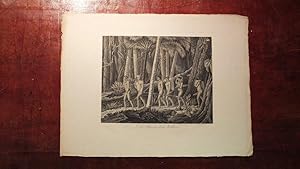About this Item
4 volumes: 2 volumes text, 4to., (13 1/8 x 10 inches); and 2 atlas volumes, portfolio (21 x 16 inches). 19 engraved plates in text volumes (chapter vignettes, printed on separate leaves), 22 engraved plates, including 5 with original hand-colour, all after Maximilian, and 3 maps by Arrowsmith, including one folding and two with original hand-colour in outline. Uniformly bound in original drab printed paper boards, the portfolios each with remains of two pairs of silk ties. Provenance: with the near contemporary ink armorial library stamp of Lauterbach on the title-pages, and small red morocco labels of the spines of the text volumes; with the small printed library label of Carlos R. Linga on the front paste-down of the text volumes; with Christie's New York 19 December 2002, lot 191 A MAGNIFICENT EXAMPLE IN ORIGINAL BOARDS. First edition, and an attractive copy. ".from a scientific point of view . was one of the most profitable of the nineteenth century. The enormous zoological collections which were assembled are today in the American Museum of Natural History of New York. the account of this journey is a classic work" (Borba de Moraes II, p. 544). Maximilian arrived in Brazil in July of 1815 and spent two years there, "aided in his research by Wied family retainers Christian Simonis (estate gardner) and David Dreidoppel (huntsman and taxidermist) and two German scientists he met in Rio de Janeiro - ornithologist Georg Wilhelm Freyriss (1789-1825) and botanist Friedrich Sellow (1789-1831). The collections and records produced under very difficult field conditions in the eastern Brazilian rain forests were prodigious and formed the bases for important publications written by the prince in subsequent years at Neuwied" (Paul Schach, introduction to "The North American Journals of Prince Maximilian of Wied: May 1832 April 1833", page xxxviii). Paul Schach in his "An Introduction to Maximilian, Prince and Scientist", states: "Reise nach Brasilien in de Jahren 1815 bis 1817" (Journey to Brazil in the Years 1815 to 1817), earned [Maximilian] high esteem not only for his exemplary description and classification of Brazilian animal life but also for his pioneering efforts in ethnology among the Botocudos and neighboring tribes. More than a century later, Professor Herber Baldus of Sao Paulo described Maximilian as 'the first scientist who ever came to Brazil for the express purpose of observing the aborigines in their native habitations. What he saw there he described thoroughly and independently of opinions of his time". "While he was working in the rain forests of Brazil, Prince Maximilian came to the realization that his observations recorded in the tropics, especially those on native peoples, needed to be supplemented with similar investigations in different New World environments. As he briefly noted in his "Reise nach Brasilien, "It would be very interesting for me to see the North-American Indian tribes for the purpose of comparing them with those of Brazil, and I intend therefore perhaps some day to undertake a journey there" (ibid, page xxxv). Palau 158782; Sabin 47018. Catalogued by Kate Hunter. Seller Inventory # 72lib1396
Contact seller
Report this item
![]()




